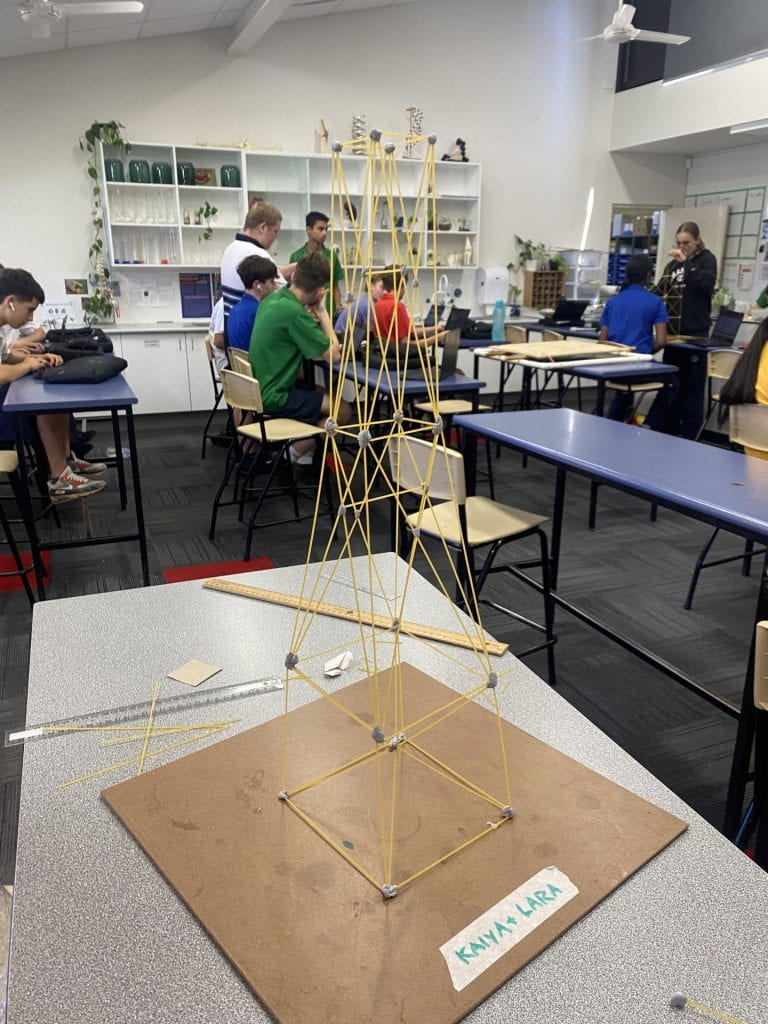Earthquakes are natural phenomena caused by the abrupt release of energy in the Earth’s crust, which predominantly occurs along tectonic plate boundaries. The impact of these seismic events is often devastating, causing the destruction or damage of buildings and resulting in numerous casualties and injuries. To mitigate these catastrophic outcomes, engineers and architects invest significant time and resources in designing and creating buildings capable of withstanding earthquakes and other natural disasters.
Over the past few weeks, working in pairs or small groups, we were given the challenge of constructing an earthquake-resistant building, made using only spaghetti and blu tack. Our prototype had to withstand an earthquake, simulated on a shaking table for 10 seconds while meeting certain rules and criteria. These included a minimum height of 60cm, a maximum base of 30 cm x 30 cm, and a flat platform on the top level of at least 5 cm x 5 cm while costing less than $60 (1 spaghetti = $1 and 1 gram of blu tack=$1).
Engineering process ☆:

Our engineering process was a comprehensive journey consisting not only of the physical construction of our prototype, but also involved the crucial stages of research, brainstorming, evaluation, redesigning, and testing. We began our project by allocating roles to each teammate based on strengths which established a solid foundation for collaboration. The initial phase involved researching and identifying the problem, looking at real-world examples to better our understanding of the project. During the research, my partner and I found out about the importance of cross-bracing through multiple different articles and examples. After designing a draft prototype based on all the research we collected, such as the importance of cross-bracing, we began building our scale model. We tested this model on an earthquake simulator where we then evaluated the results. Using the strengths and weaknesses of our model on the simulator, we rebuilt our model. This combination of tasks resulted in an effective project outcome, as well as fostering a deeper understanding of the importance of the whole engineering process.
While I am pleased with the final result of our tower, there are a few changes I’d make to the process and will learn from. Primarily, I would research the project’s initial stages. During the first few lessons, my partner and I found ourselves off track, engaging in disputes over roles and responsibilities. This initial discord slowed us down for the rest of the project, forcing us to spend a lot of time working on it at home. We were a bit behind the rest of the class, starting our second prototype a lot later than everyone else. This created a lot of stress around the project, a situation entirely avoidable with more streamlined coordination from the project’s inception.
Collaboration ☆:
Collaboration is a vital part of any group or partner project that can make or break the outcome. I was worried at the beginning of the project, as I’ve previously had bad experiences with my partner, but working with her diverted my expectations and made the project flow very smoothly.
For the start of the project, my partner and I stayed true to our initial role allocations; my partner focused on the hands-on building elements, while I focused on the research point of view. But the deadline grew closer, we decided to work on the elements of the project together. My partner is very strong creatively so she could easily imagine a design of the prototype, quick to re-think parts of the building that didn’t work or could’ve been done better. I was better at the research and evaluation portion of the project, being able to notice flaws in our first prototype so we could improve in our next build, as well as incorporating research in our prototype and design to produce an effective earthquake-resistant building. We meshed together well, being able to work efficiently on the construction of the tower while collaborating on each other’s needs and concerns, which successfully contributed to final outcome of the project.

